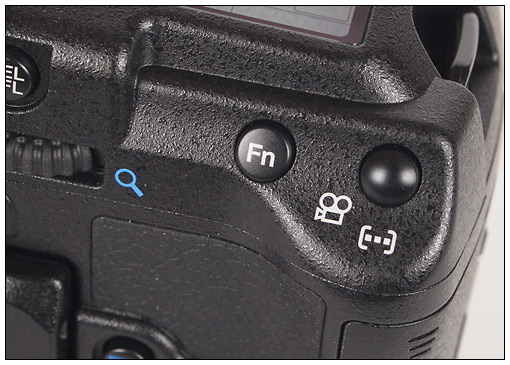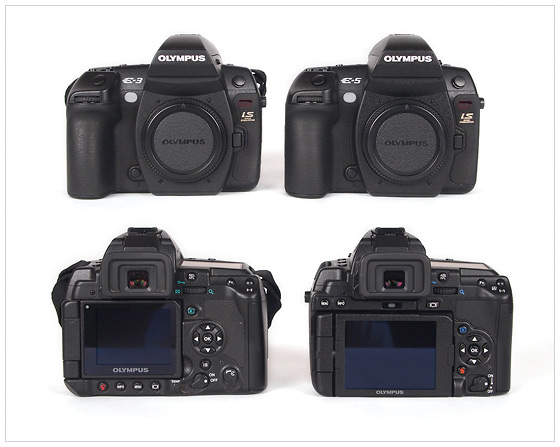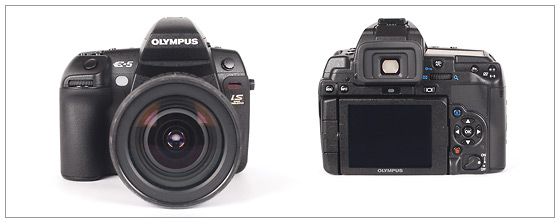 It took them three years to do it but Olympus finally has a new professional digital SLR – the E-5. And I was one of the lucky few that got a pre-production camera to play with. At first glance the Olympus E-5 looks almost exactly the same as its predecessor, the E-3 (see comparison photos at the bottom of the page). But when you turn it around you immediately notice the huge 3-inch tilt-swivel LCD. They had to move some buttons around to make way for that big slab of an LCD but aside from that the controls appear to be the same – except for one – the auto focus point selector now doubles as a video button. That’s right, the new Olympus E-5 has video – 720p HD Motion JPEG at 30 frames per second, to be exact. It also sports a 12-megapixel High Speed Live MOS Sensor. That’s 20% more pixels than the E-3 and hopefully better all-around image quality.
It took them three years to do it but Olympus finally has a new professional digital SLR – the E-5. And I was one of the lucky few that got a pre-production camera to play with. At first glance the Olympus E-5 looks almost exactly the same as its predecessor, the E-3 (see comparison photos at the bottom of the page). But when you turn it around you immediately notice the huge 3-inch tilt-swivel LCD. They had to move some buttons around to make way for that big slab of an LCD but aside from that the controls appear to be the same – except for one – the auto focus point selector now doubles as a video button. That’s right, the new Olympus E-5 has video – 720p HD Motion JPEG at 30 frames per second, to be exact. It also sports a 12-megapixel High Speed Live MOS Sensor. That’s 20% more pixels than the E-3 and hopefully better all-around image quality.
The new Olympus E-5 includes all of the cool features that made the E-3 a groundbreaker in 2007 – a tilt-swivel LCD (bigger and better); Live View, built-in sensor-level image stabilization; Supersonic Wave Filter dust-reduction system; and a weather-sealed body with a burly magnesium chassis. Now it also includes some of the cool features Olympus introduced later – Art Filters; selectable aspect ratios, and I believe it has the same built-in electronic level Olympus debuted in the E-30. It also uses the excellent Zuiko Digital lens line. One of the things that’s often said about Olympus is they don’t make a bad lens – even their kit lenses are excellent.
Olympus E-5 DSLR Hands-On Video Preview
I had a pre-production E-5 for a few days. I took a few pictures, shot some video with it (and of it) and basically got a feel for the camera. In spite of the increased resolution (compared to the E-3), larger LCD and HD video, the E-5 doesn’t feel like a dramatic update. For the most part it looks, handles and behaves like the E-3. I have to admit I found myself thinking it wasn’t quite enough. That may be a hasty reaction, though. The Nikon D3S and D700 are both 12-megapixel cameras and no one looks down on them. Yes, they both have full-frame sensors but still – I believe the 12-megapixel Four Thirds sensor has room for improvement. Olympus says of the image quality, “The E-5 camera achieves the highest image quality of any Olympus camera by pairing a 12.3 megapixel High-Speed Live MOS Sensor with a TruePic V+ image processing engine that boasts new “Fine Detail Processing” technology for greater detail in the photograph.” The camera I had didn’t have final firmware so I’m not allowed to share any of the photos I took and I didn’t do any kind of scientific comparison. But I’ll go out on a limb and say ISO 800 looked pretty damn good. Unfortunately, you’ll just have to take my word for it.

The Olympus E-5 will be available in October for $1699.99.
Olympus E-5 Digital SLR Official Press Release >>
Related Content:
All Olympus User Reviews
All Digital SLR Reviews
Olympus Cameras & Four Thirds Forum
Digital SLRs Forum
Olympus Digital Cameras Web Site
Olympus E-5 Compared To Olympus E-3




Holy crap! Digital SLRs at the pro-level are expensive!
Actually, $1699 isn’t so bad compared to some other high-end Digital SLRs.
Is 800 ISO highest decent setting?
Ramine-
Like I said in the article, the camera I had wasn’t a production camera and I wasn’t allowed to share any test photos. Because of that I didn’t bother to really test it or even pay attention to what the auto ISO was doing. I only looked at my photos later, while I was writing the article. I didn’t actually shoot anything above ISO 800 so I can’t say. But like I said, ISO 800 looked very good and I expect higher ISO settings will also be good. But I can’t pass any serious judgement until I have a full production camera in the studio for testing.
Very poor showing the E-5, competitively I must leave my Oly system behind and move on. How disappointing.
Kevin-
What is it you think is missing from the E-5? What do you think would make it a worthy successor to the rest of the Olympus DSLR line?
I’m pretty excited for the release of this camera. I was going to the pull the trigger on the E-3 glad I did not do it! However certain things i don’t is that fact you cant use the older batteries from the E systems, which stinks cause i have the battery pack, but always good use for the back up camera, but cant wait to get my hand on this!
What are you using now, Atif?
I have both E-3 and E-30. I have said that if Olympus puts the E30 into the E3, we have a winner and it seems that the E5 is it. I regret that they did not put the E30 mode button and I am seriously concerned about the image quality at high ISO. Video is a useless tool for this type of camera but I may discover something knew. I just do not know if I will have the patience to wait your indept image review before ordering it. Thanks for the review.
im sale
Atif -
You can use the current BLM-1 battery (used in the E-3). It is slightly lower voltage than the new BLM-5, but it will fit and work in the new E-5 camera. The new battery also has contacts that are recessed a bit to avoid shorting.
- Joe
Hmm. I think, for the price, the Pentax K-5 is much more compelling.
Another great review, loads of detail.
We also made a review video of this camera from Photokina, but we don’t give quite as much detail as you.
http://convergeevents.co.uk/2010/10/converge-events-photokina-olympus-e5-review/
After a three-year hiatus, Olympus produced a camera that is technically below their competition such as 12.3 mp vs. 18 mp., slower 5 fps vs. 8 fps., and priced higher $1,699 vs. $1,399. Yes, I’m referring to the competitor model, Canon 7D. Olympus has a video feature that is inferior to the Canon model. I still shoot with the E-3 and E-30. But the Canon 7D is becoming my workhorse. I foresee the Olympus E-5 price reduction in the near future because of lower priced makes and models with superior basic features.
What Olympus has Done again is absolutely amazing. It is a game changer.
It has removed the part of the AA filter that causes the image to be Blurred during capture. Now you can get the full resolution of your lens.
Pixel by pixel processing.
Do not be fooled by the 12 MP. Resolutions of 3000-3500 LPI could be there. That gives you the best image quality and lower noise levels. I was quoted 60-70 line pairs per mm. This is the same resolution as my Canon 5D Mark II with in camera IS.
The jpegs that I saw were amazing 30×40 in no noise at 200 ISO.
It appears to have all the other key things plus some new art filters.
I too would like to see the price at around $1300.
I still have not upgraded to the E-5 but will as soon as Xmas is over and cash is abit more flush. Remember fellow artists, it’s all about the glass. I have been shooting the 90-250 f.2.8, 35-100 f2.0 and 12-60 f2.8/4.0 and the photos are spectacular. I have not picked up my Canon 7D or 5D in over 6 months. They too are good tools but are larger, heavier and the glass is more variable. Believe me 10-12 mpixels is more than enough if you’re exposure and focus is on.